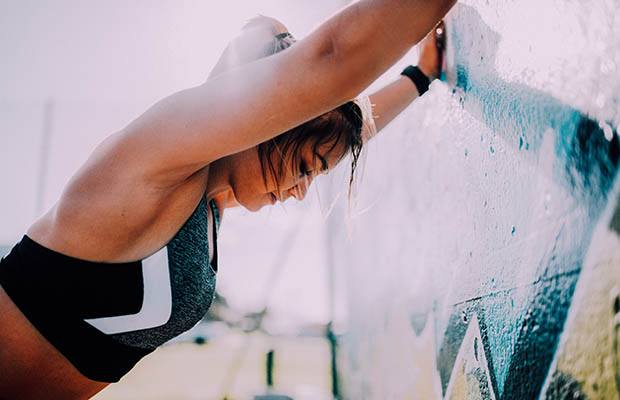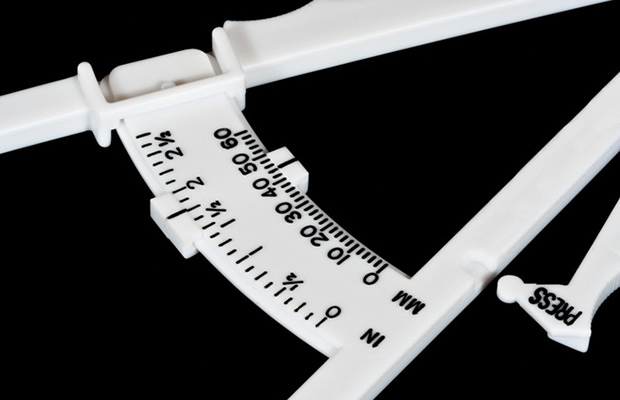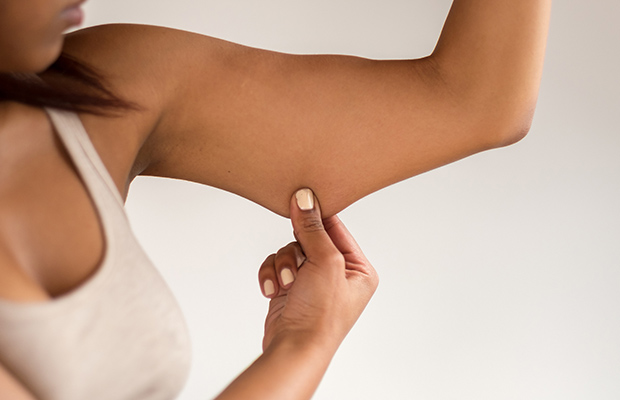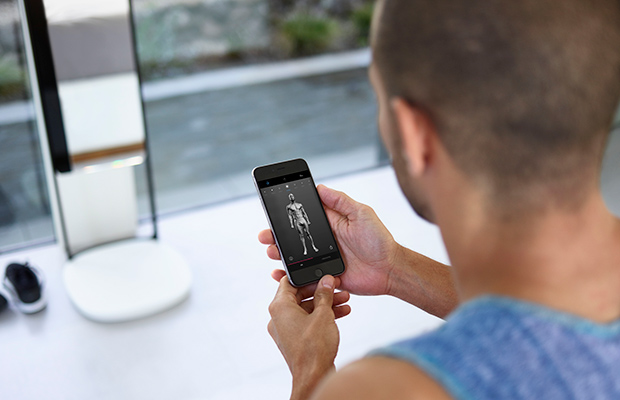
Photo: Twenty20
Whether your priority is looking good in a bathing suit or living to see 100, there’s one piece of information that might stand in the way: body composition. Many people overlook this important metric, or the measure of fat mass to lean tissue, including bone, muscle, ligaments, tendons and organs. Higher body fat percentage has been linked to an increased incidence of diabetes, high blood pressure and other heart risks. And the overall amount isn’t the only concern; distribution of body fat matters, too. For some individuals, increased levels of abdominal fat have been tied to higher risks of heart disease and cancer compared to fat distributed across the rest of the body. So, how exactly do you track body fat?
A quick Google search will reveal dozens of methods to measure body composition, ranging from the quick and (relatively) painless to the incredibly detailed. These measurement techniques can help individuals determine how to set baseline values for body composition and future goals. However, with the variation in methods comes a fluctuation in accuracy. While one method might calculate your body fat percentage to within a few decimals, others leave a wider range of error. To help you navigate the numerous techniques, read on for the top five methods for measuring body fat percentage, along with the pros and cons of each.
RELATED: The Truth About How to Lose Belly Fat
How to Measure Body Fat Percentage

Photo: Pond5
1. Skin Calipers
It might not be St. Patrick’s Day, but get ready to be pinched! Perhaps the most accessible method for measuring body composition, technicians perform a skin fold assessment using either three, four or seven sites (meaning parts of the body). The technician doing the test first pinches the skin. Then, he or she uses the skin caliper device to measure the thickness of the skin fold for each site. Each protocol has specific sites for testing, commonly including the chest, arms, abs and thighs. After plugging the numbers into a formula, practitioners can estimate body fat percentage.
The Pros
Since calipers are relatively inexpensive (about $10 per pair), the skin fold method is the most easily accessible of all the methods listed here. Most gyms will have a pair handy. And you can expect more than a few trainers on staff to have adequate experience using them. Eager to keep close tabs on your progress? Consider investing in a pair of calipers for at-home testing. (Remember though, it does take considerable practice to be able to accurately self-administer the test.) Bonus: A proper skin fold assessment can be completed in just a matter of minutes, anytime or place.
The Cons
This method relies on readings from only a handful of body parts, so margin for error can vary. This highly depends on the experience and knowledge of the technician. To minimize error, Jessica Kneeland, personal trainer and founder of Remodel Fitness, says “The most important thing is to use the exact same spots every time. Consistency with calipers takes practice, so the key is to practice a lot — or find an expert technician.” Body fat distribution can factor into the accuracy level as well. Although the test takes a measurement from each main area of the body (including the upper body, midsection and lower body), a participant that holds greater amounts of fat outside of the measured areas might end up with a lower reading.
RELATED: How to Calculate Your Basal Metabolic Rate (BMR)

Photo: Pond5
2. Bioelectrical Impedance
Although the name might sound intimidating, bioelectrical impedance is far from shock therapy. In fact, users won’t even feel a thing. Bioelectrical impedance scales range from the simple (a normal scale with electrodes under each foot) to the complex (a scale that has handholds with additional electrodes). Regardless of the machine, the devices work by sending tiny electrical impulses through the body and measuring how quickly those impulses return. Since lean tissue conducts electrical impulses quicker than fatty tissue, a faster response time is correlated with a leaner physique.
The Pros
Bioelectrical impedance monitors tend to be affordable enough to keep one around the house. In fact, many traditional weight scales come with built-in body composition features that can generate and track body fat percentage alongside bodyweight. Outside of the house, you can find bioelectrical impedance monitors at many gyms and personal training studios. (You might need to pay to use them.) Since this technique requires little more than pressing a button, users need little to no previous practice. Plus, you’ll get measurements in a matter of seconds.
The Cons
The skill and time trade-off comes at an expense: accuracy. Bioelectrical impedance measurements are generally much less accurate than methods like DEXA scans (see below). Readings can be greatly affected by variables like hydration levels (since water also conducts electrical impulses), meal times (a recent meal can skew results), and workouts (taking a reading directly after exercise leads to a lower body fat reading). Kneeland, who uses a bioelectrical impedance device called an InBody Machine with clients, acknowledges that it’s crucial for clients to follow a set protocol. That’s especially important in terms of food and fluid intake. How to get a most consistent reading? Take readings at similar times during the day and in the same conditions, Kneeland says.
RELATED: How Often Should You Weight Yourself?
3. Hydrostatic Weighing
If the thought of getting dunked underwater suits your fancy, this might be the method for you. Hydrostatic weighing, commonly referred to as underwater weighing, compares a subject’s normal bodyweight (outside the water) to his or her bodyweight while completely submerged. Using these two numbers and the density of the water, operators can accurately calculate the subject’s density. This number is then used to estimate body composition.
The Pros
Hydrostatic weighing is an incredibly accurate technique for measuring body composition. The technique uses tried and true variables that feature a low percentage of error. For that reason, many experts refer to hydrostatic weighing as the gold standard for measuring body composition. It’s also commonly used in research settings.
The Cons
Unless you happen to have an underwater scale at home, you’re going to have to find a lab or a performance center for this. As a result, this method can be a bit inconvenient. It’s more expensive (ranging from $40 to $60) compared to other techniques, too. Subjects also have to forcefully exhale as much air out of their lungs as possible to reduce potential for error and sit submerged completely underwater. This might be uncomfortable for some individuals.
RELATED: Weight Fluctuations: What’s Normal and What’s Not
4. DEXA (Dual-Energy X-Ray Absorptiometry)
Think X-rays only detect broken bones? A DEXA scan exposes patients to X-ray beams of differing intensities. And experts use it to calculate bone mineral density alongside body composition. Participants lie still on a table while a machine arm passes over their entire body. This arm emits a high- and a low-energy X-ray beam. By measuring the absorption of each beam into parts of the body, technicians can get readings for bone mineral density, lean body mass and fat mass. Also, because the machine scans body parts individually, the test can also break down body composition per limb. That means you can confirm suspicions that your right leg is indeed just a bit stronger than your left.
The Pros
Like hydrostatic weighing, DEXA scans are incredibly accurate at measuring body composition. Whereas hydrostatic weighing involves dunking under the water, a DEXA scan simply involves lying on a table for a few quick, dry and painless minutes.
The Cons
Like the hydrostatic weighing method, don’t count on around-the-clock availability of DEXA’s advanced technology. Getting a DEXA scan usually involves making an appointment with a medical professional. The high level of accuracy also comes at a relatively high price tag (which will vary by location) compared to other methods.
RELATED: The 15 Most Underrated Exercises, According to Trainers
5. Air-Displacement Plethysmography
Don’t let the name intimidate you. Air-displacement plethysmography is actually very similar to underwater weighing. First, participants sit in a small machine, like this “BOD Pod.” Then, by measuring how air displacement by the individual, technicians can determine body density. Like underwater weighing, the participant’s body density is then used to calculate body composition.
The Pros
Since the air-displacement plethysmography method doesn’t involve dunking your head underwater, many subjects will find it more comfortable. The shape and size of the machine used in this technique, which typically resembles an egg, makes it accommodating for almost any age, shape and size.
The Cons
Along with DEXA and underwater weight, you won’t find air-displacement plethysmography in your neighborhood gym. While commercial machines might pop up at select high-level training facilities, locating one near you might be difficult. Plus, the cost (between $45 and $60 per reading) is another factor to consider.
RELATED: 3 Quick HIIT Workouts for Beginners

Photo Courtesy of Naked Labs
6. 3D Body Scan
You’ll see this option become more readily available and accessible. Several brands offer at-home devices that scan your body, take circumference measurements of different body parts and then track your body fat via a corresponding app. Many can also tell you your muscle mass. One example: The at-home machine, Naked ($999, accepting preorders now). It’s a full-length mirror embedded with sensors that use infrared light to provide a full-body 3D image. It also comes with a turntable to read your weight and provide a 360-degree body view. Similarly, mPort ($5/month for the app subscription) creates a 3D image of your body using infrared light and circumference measurements. You can find these machines in several LA Fitness locations, most commonly in California. Styku is another body mapping machine, offering similar readings.
The Pros
For most body types, 3D mapping comes within two percent of the accuracy of the DEXA method. Because of the devices’ corresponding apps, you can also easily and frequently track your progress and find small changes you wouldn’t normally notice. That’s even simpler with a machine like Naked, which you can use in the comfort and privacy of your home. While accuracy improves if you do a scan at the same time every day, you don’t need to worry about hydration or meal times like you do with bioelectrical impedance.
The Cons
You do, however, need to worry about your clothes. You’ll get more accurate number when you’re naked. But if you prefer, tight pants and a top also works. Just remember to wear that same outfit for every reading. Standing as still as possible during the scan is also how to ensure the most accurate results.
Remember the Big Picture
Regardless of which metric you go with, resist the urge to test on a weekly basis. According to Kneeland, results take time. “I encourage new clients to wait at least six to eight weeks before re-measuring their body fat percentage,” she says. “At first I just want them focusing on implementing good habits and noticing how they feel.” As for which testing procedure to try, find a method that works for you — then stick with it. Though bioelectrical impedance and skin calipers tend to be slightly less accurate than more high-tech methods like underwater weighing, they can still be an incredibly useful tool. And remember, body composition should be just one metric on the road to health and fitness. Sleep quality, energy levels and happiness should also take priority. So don’t make body fat the entire focus of your training.
Originally posted on December 30, 2013. Updated February 2018. Additional writing and reporting by Mallory Creveling.
Read More
Is Weight Loss As Simple as Calorie Counting?
7 Ways to Naturally Boost Your Metabolism
3 Fat-Blasting HIIT Workouts to Try Now







































